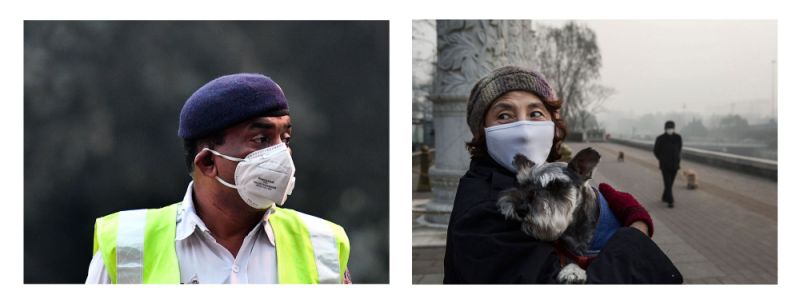(Bloomberg Opinion) — Medical masks are unusual artifacts.
Throughout history and across the globe, most masks have served to disguise, cloak or alter identity, whether in the special circumstances of ritual and theater, the perpetuation of crimes or the veiling of women. Medical masks, by contrast, are meant not to hide but to protect. They maintain the wearer’s identity while encouraging solidarity rather than segregation.
Here is a brief illustrated history of their evolution.
17th-century Europe
Plague doctors adopt a costume that includes a leather headdress with a long, pointed beak filled with perfumes and aromatics that masked bad odors and were believed to combat contagion carried by bad air. Stylized versions of the costume became popular in stage productions and carnival celebrations. This historical illustration shows the entire outfit. The mask is preserved in the Deutsches Historisches Museum in Berlin.
19th century
Fashionable women wear lacy veils to protect against dust, particularly from the disruptions of Georges-Eugene Haussmann’s remaking of Paris. As germ theory spreads, the fashion takes on a medical aura when researchers using microscopes find bacteria on dust particles.
In an 1878 article printed in the Hospital Gazette and in Scientific American, A.J. Jessup, a Westtown, New York, physician, recommends cotton masks to limit contagion during epidemics:
Thus we see that as quarantine and disinfection will certainly spread of contagion from patient to patient, may we not confidently hope, by preventing the entrance of germs into the lungs and blood, by a properly constructed filtering mask to yet witness the spectacle of a population walking about the streets of a cholera infested city, without fear of its infection however deadly. As a properly made cotton filter worn over the mouth and nose must shut out all atmospheric gems of the ordinary putrefactive kind. We may confidently assured that those of disease will be equally excluded.
He cites his experiments with test tubes with and without cotton stoppers. His idea does not catch on.
Early 20th century
Although the first study advocating the use of masks during surgery is published in 1897, they are rare at the turn of the century.
In 1905, Chicago physician Alice Hamilton publishes an article in the Journal of the American Medical Association, reporting on experiments measuring the amount of streptococci bacteria expelled when scarlet fever patients cough or cry. She also measures the strep bacteria from healthy doctors and nurses when they talk or cough, leading her to recommend masks during surgery.
“I was told by a student in a large medical college in Chicago,” she writes, “that he had often noticed at the clinics of a certain surgeon that, when the light was from a certain direction, he could see, from his seat in the amphitheater, a continuous spray of saliva coming from the mouth of the surgeon while he discoursed to the class and conducted his operation. Obviously, protection of the mouth, of some sort as to catch and impression the droplets of sputum, should be a routine precaution for surgeons and for surgical nurses during operations.”
In 1910, an epidemic of pneumonic plague strikes Manchuria. Appointed by the Chinese court to head anti-plague efforts, the Penang-born, Cambridge-educated physician Wu Lien-Teh (Wu Liande) argues that the disease is transmitted through airborne contact. To prevent its spread, he develops masks to be worn by medical personnel and the general public.
During the 1918 global flu epidemic, medical personnel routinely adopt masks to protect themselves, and many cities require them in public. In Seattle, where streetcars require all riders to have masks, the local Red Cross enlists 120 workers to turn out 260,000 masks in three days.
In the 1920s, masks are standard in operating rooms. Over the next century, medical researchers continue to experiment with designs and materials.
Post-World War II
Choking air pollution, particularly in London, leads Britons to adopt “smog masks.”
As advanced economies clean up their pollution, smog — and smog masks — move to India, China and other developing countries.
In January 2010, a month before his death from suicide, fashion designer Alexander McQueen shows a menswear collection titled “An bailitheoir cnámh,” (“the bone collector” in Gaelic) that features face masks and balaclavas.
While McQueen’s work was artistic and conceptual, designers targeting the Chinese market increasingly include masks sold as fashionable accessories alongside bags and jewelry. These models are from designer Masha Ma’s autumn/winter 2015 collection, in March 2014, and Xiong Ying’s Heaven Gaia autumn/winter 2019-20 show in March 2019.
In 2018, singer Ariana Grande includes face masks in the merchandise lineup backing her “Sweetener” album. The pop star continues to roll out limited-edition masks. Currently featured: “Santa Tell Me” and “Christmas and Chill.”
As the coronavirus sweeps the globe, sewing face masks and 3D printing surgical shields becomes the 21st-century version of rolling bandages and knitting socks for the troops.
This column does not necessarily reflect the opinion of Bloomberg LP and its owners.
Virginia Postrel is a Bloomberg Opinion columnist. She was the editor of Reason magazine and a columnist for the Wall Street Journal, the Atlantic, the New York Times and Forbes. Her next book, “The Fabric of Civilization: How Textiles Made the World,” will be published in November.
<p class="canvas-atom canvas-text Mb(1.0em) Mb(0)–sm Mt(0.8em)–sm" type="text" content="For more articles like this, please visit us at bloomberg.com/opinion” data-reactid=”72″>For more articles like this, please visit us at bloomberg.com/opinion
<p class="canvas-atom canvas-text Mb(1.0em) Mb(0)–sm Mt(0.8em)–sm" type="text" content="Subscribe now to stay ahead with the most trusted business news source.” data-reactid=”73″>Subscribe now to stay ahead with the most trusted business news source.
©2020 Bloomberg L.P.













Add Comment